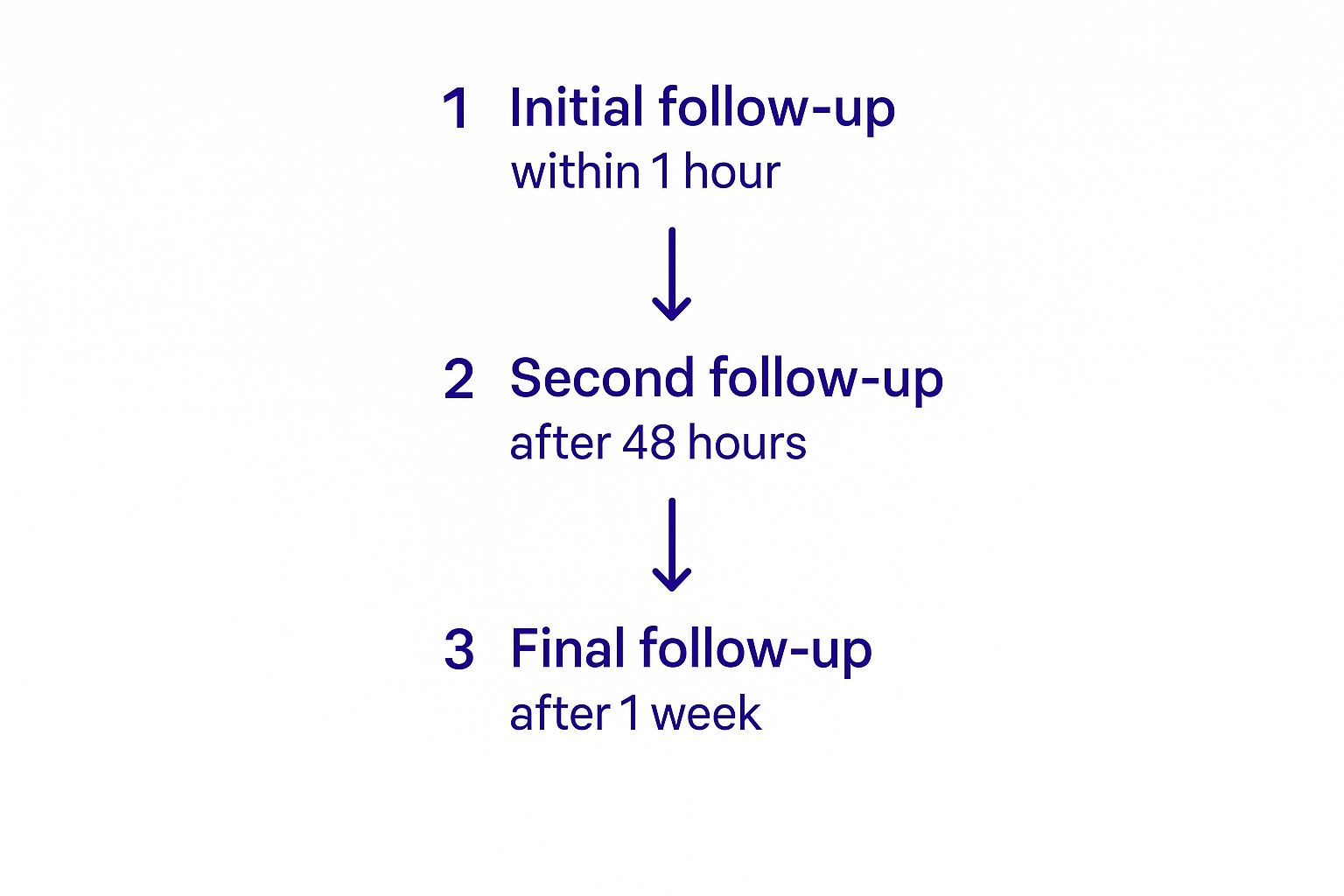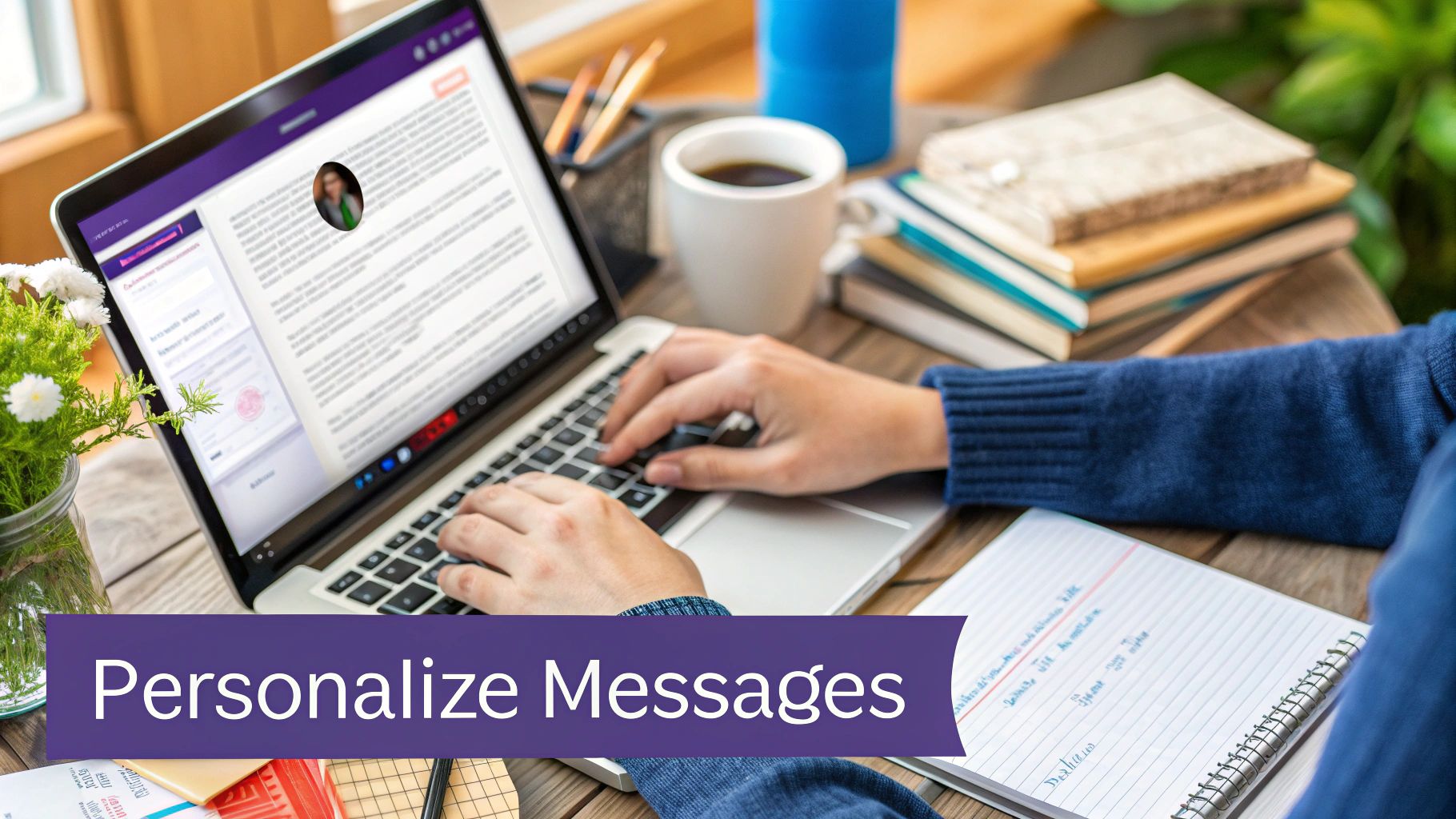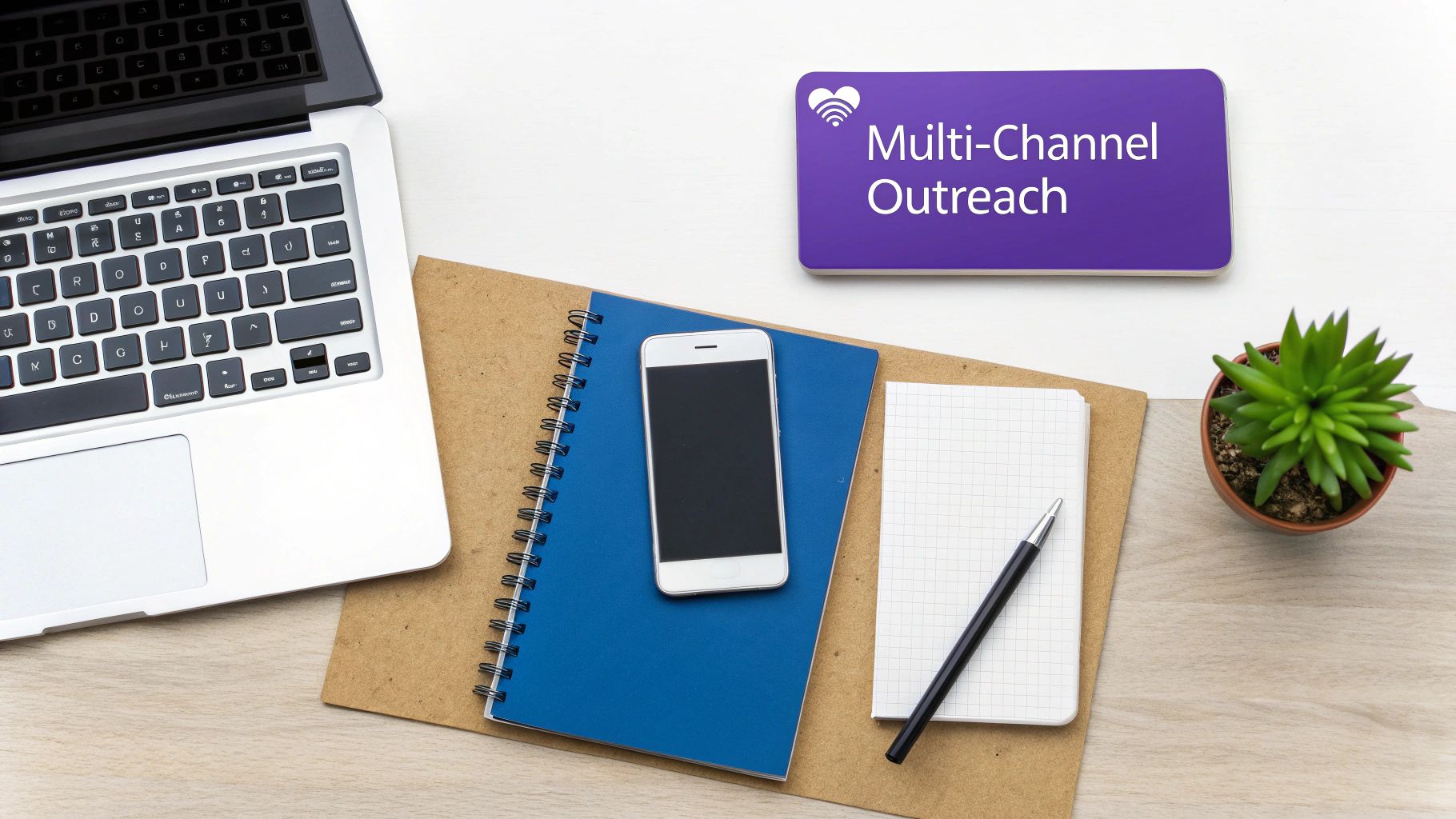If you want to get serious about turning leads into customers, you have to stop thinking in terms of sporadic check-ins. The real magic happens when you build a persistent, value-driven strategy. It’s about combining timely outreach with personalized messaging across different channels, turning a simple contact into a genuine conversation that helps your prospect find a solution.

Let's be honest for a second. Does your current follow-up process feel like you’re just shouting into the void? You get a great list of contacts from a webinar, fire off a few emails, maybe make a call or two, and then... crickets.
This is a classic story, but the problem usually isn't bad leads. It's a broken process.
More often than not, the failure points are inconsistent timing and generic, one-size-fits-all messaging. When you treat follow-up as an afterthought, even the most promising opportunities go cold fast.
The numbers here tell a really clear story. There's a huge disconnect between what it actually takes to close a deal and what most sales teams are doing. For instance, 80% of sales require at least five follow-up attempts.
But here's the kicker: a staggering 92% of sales reps give up after just four tries. Think about that. Even crazier, 95% of converted leads are finally reached on the sixth call attempt.
This is where most sales are lost—not because of a lack of interest, but from a simple lack of persistence. Giving up too early is the biggest unforced error you can make.
To fix this, the mindset has to shift from random check-ins to a structured, systematic conversation. A winning strategy isn't about just reminding someone you exist; it's about proving you can solve their problem with every single touchpoint.
For a deeper dive into building a complete framework, from timing your outreach to automating the process, I highly recommend exploring this guide on mastering the art of following up on a lead. It really breaks down the psychology of what works and gives you a roadmap for turning lukewarm interest into a solid sales opportunity.
In sales, timing isn’t just a detail—it’s everything. When a prospect submits a form, downloads a guide, or requests a demo, their interest is at its peak. This is your moment. Acting within this brief window is probably the single most impactful thing you can do to turn a curious browser into a serious buyer.
This initial period is what we call the "golden window" for a good reason. Wait even an hour, and your odds of connecting plummet. The data is pretty stark: leads contacted within the first five minutes are nine times more likely to convert. Yet, 41% of companies admit they struggle with speedy follow-ups, which means they're leaving a ton of money on the table. If you want to dig into the numbers, these lead generation statistics from Exploding Topics are really eye-opening.
Think about it this way: if someone in a meeting raises their hand, you don't ignore them and circle back the next day. You answer them immediately. The same logic applies here. A fast follow-up tells the lead you're on the ball, attentive, and ready to help. It validates their interest right when it’s strongest.
Your first touchpoint doesn't have to be a full-blown sales pitch. A simple, helpful email confirming they got what they asked for or a quick call to offer assistance is perfect. This small gesture instantly turns a passive inquiry into an active conversation and sets a positive tone for everything that follows.
This flow chart gives a great visual of how to think about the timeline for your first few attempts.
As you can see, the strategy is front-loaded. You concentrate your efforts in the first few days when the lead is "hot" and then space out your touchpoints as time goes on.
Once you've made that critical first contact, you need a plan. A good follow-up cadence keeps you on their radar without becoming an annoyance. It’s all about mixing up your communication channels and adding real value at every step, which is how you build trust.
The point of a follow-up cadence isn't just to remind someone you exist. It's to consistently prove you understand their problems and have solutions. Every message is a chance to be genuinely helpful.
Here's a sample multi-channel schedule I've seen work incredibly well. It provides a solid framework but leaves plenty of room for you to personalize each interaction based on who the lead is and how they're engaging.
Use this sample schedule to structure your first seven follow-up attempts, blending different channels to maximize engagement without overwhelming your lead.
Following a structured approach like this ensures you're both persistent and professional. You're systematically guiding the lead through their journey, and by consistently showing up with useful information, you stop being just another salesperson and become a trusted advisor.

Let's get one thing straight: the single biggest mistake you can make when you follow up on leads is sending the dreaded "just checking in" email. We've all received them, and we've all deleted them. It offers zero value and puts all the work on the other person.
To get a reply, your message needs to be a welcome interruption, not an annoying chore. You have to shift your mindset from "selling" to "solving." Instead of begging for their time, offer them a genuine insight. That simple pivot is the difference between being ignored and starting a real conversation.
Crafting a message that cuts through the noise is part art, part science. It doesn’t need to be an essay; it just needs to hit the mark. The best follow-ups I've seen—the ones that consistently get replies—are built on three core pillars.
Get these right, and your message will stand out:
A great follow up feels less like a sales pitch and more like a helpful note from a knowledgeable peer. When you consistently provide value, you build trust, and trust is what ultimately closes deals.
So, how does this look in the real world? Let’s say you’re following up with a lead who attended your webinar on project management software.
A weak, generic follow-up would be something like this:
"Hi Alex, just checking in to see if you had any questions after the webinar."
Boring, right? It’s forgettable and easy to ignore. Now, let’s inject our three pillars to create something that actually works.
A Better Follow Up Email Template
Here’s a simple structure you can adapt for just about any scenario:
The Hook (Personalization): Kick things off with a direct reference to your last interaction. It immediately jogs their memory.
The Value Add (Helpfulness): Give them a resource that directly addresses what they care about.
The CTA (Clear Next Step): End with a simple, closed-ended question that’s a breeze to answer.
This approach completely flips the script. You’re no longer a salesperson asking for something; you’re a helpful expert offering something. This simple, value-first structure is how you turn a one-way message into a two-way dialogue and watch your reply rates climb.

Let's be honest. Trying to manually track every single lead, remember every conversation, and time every touchpoint perfectly is a recipe for burnout. It’s simply not sustainable. Sooner or later, important details slip through the cracks, and opportunities that were once warm go ice-cold.
This is exactly where technology stops being just another tool and starts acting like your most valuable teammate.
When people hear "automation," they often think it makes follow-up robotic or impersonal. I've found the opposite is true. By handing over the repetitive, manual tasks to a system, you actually free up your time to focus on what humans do best: building real relationships, truly understanding a prospect's needs, and closing deals.
The bedrock of any smart follow-up strategy is a solid Customer Relationship Management (CRM) platform. Think of a CRM like HubSpot or Salesforce as your team's central nervous system—it’s the single source of truth for every bit of data on your leads and customers.
Inside your CRM is where the magic happens. You can build automated workflows that spring into action based on specific things your leads do.
For instance, when a new lead downloads an ebook from your website, your CRM can be set up to:
A well-configured CRM ensures your entire team—from marketing to sales to customer support—has the same unified view of every lead. This is huge. It completely eliminates the guesswork and makes for a buttery-smooth handoff between departments.
The goal of automation isn't to replace salespeople; it's to supercharge them. A well-built system handles the logistics so your team can focus entirely on creating meaningful conversations and solving customer problems.
While CRMs are fantastic for managing workflows, the new kid on the block—conversational AI—takes things to a whole new level. These AI agents, like the ones we build at Upcraft, can actively engage leads for you, handling that crucial initial outreach and qualification process from start to finish.
Imagine an AI agent as a tireless sales development rep who works 24/7. It can:
This isn't some far-off concept; it’s a real-world advantage teams are using right now. In fact, AI-powered systems can drive up to 83% higher revenue for sales teams by nailing the timing, personalization, and prioritization of every single follow up on leads. AI is brilliant at figuring out the perfect moment to reach out and tailoring the message based on all the data it has. You can dig into more of these powerful sales follow-up statistics to see how much of a game-changer this is.
By bringing AI into the mix, you ensure every lead gets an immediate and intelligent response. This lets your human team step in only when a prospect is truly qualified and ready to talk, creating a seamless, efficient, and incredibly effective follow-up machine that just plain works.
Your follow-up strategy is only as strong as the system it’s built on. Think of your Customer Relationship Management (CRM) software as more than just a digital address book—it's the central command for a consistent, scalable process to follow up on leads. Without a solid setup, even the best plans will fizzle out.
It's like the difference between a messy garage and a master woodshop. In one, you can't find anything, projects stall, and frustration builds. In the other, every tool has its place, the workflow is seamless, and you can create incredible things. Your CRM needs to be that woodshop.
Before you can automate a single task, you need a crystal-clear map of how a lead moves through your sales process. Default statuses like "New" or "Contacted" just don't cut it—they’re far too generic. You need to create custom lead statuses that actually reflect the conversations and milestones that happen in the real world.
This isn't just about organization; it's about clarity for your entire team. Anyone should be able to glance at a lead and know exactly where things stand and what comes next.
Here’s a practical example of statuses that reflect real progress:
This kind of structure gives you an accurate pipeline at a glance and stops good leads from getting lost in a vague "contacted" bucket. It also sets the stage for some really powerful automation.
Once your lead statuses are locked in, you can start building automated workflows that do the heavy lifting for you. These are essentially simple "if-then" rules that trigger actions when a lead's status changes or when a certain amount of time passes. This is the secret to maintaining a perfect follow-up cadence without burning out your team.
For your CRM to be a reliable engine for these workflows, the data inside has to be clean and accurate. It’s worth exploring best practices for CRM data hygiene to make sure garbage data isn't derailing your efforts.
A simple but highly effective workflow is the automated task reminder. For instance, when a sales rep changes a lead’s status to "Connected & Qualified," the system can automatically create a task for them to schedule a demo within 48 hours. It’s a simple backstop that ensures the momentum is never lost.
Your CRM setup should make the right next step the easiest step for your sales team to take. Automation isn't about replacing people; it's about freeing them from administrative tasks so they can focus on building relationships.
By making it easy to log every call, email, and meeting, you create a complete story for every contact. This discipline is what allows your team to personalize every single interaction and provides you with the hard data needed to see what’s actually working.
Even with a perfect plan on paper, the real world has a way of complicating things. When you're in the trenches trying to follow up on leads, a few key questions always seem to come up.
Let's break them down.
This is the big one, isn't it? It’s a fine line between being persistent and feeling like you’re being a pest. But here’s the hard truth, backed by data: persistence is everything.
It might feel like a lot, but research shows that 80% of sales require at least five follow-up attempts. The shocking part? Most salespeople give up after just two.
A solid rule of thumb is to aim for a cadence of five to seven touchpoints, spaced out over a few weeks. The real secret, though, isn't the number—it's what you do with each touchpoint. Don't just "check in." Add value every single time. Send them a relevant article you just read, a case study that speaks to their specific problem, or a quick tip.
This small shift in approach changes everything. You stop being a salesperson chasing a commission and start being a valuable resource.
Honestly, there’s no silver bullet here. The "best" channel is actually a mix of them. A multi-channel strategy is king because it meets your leads where they already are.
Think about it. Combining the scale of email with the personal touch of a phone call and the professional context of LinkedIn creates a powerful, layered approach. You become more memorable and a lot harder to ignore.
Here’s a sequence I’ve seen work wonders time and time again:
This strategy covers your bases and dramatically increases your odds of getting a response.
The antidote to being annoying is simple: be genuinely helpful. You have to completely reframe your mindset from "just checking in" to "genuinely helping out." Every single message should offer something of value to the person on the other end.
The core principle is simple: if your follow-up helps the prospect solve a problem or learn something new, it will never feel annoying. It will feel like good customer service.
Keep your messages short and to the point. Always show you respect their time, and make it incredibly easy for them to opt-out if they're not interested. A respectful, value-first approach builds trust. Even if they don't buy today, you'll leave the door wide open for the future.
Ready to stop leads from slipping through the cracks? Upcraft builds intelligent conversational AI agents that engage, qualify, and book meetings with your leads 24/7. Discover how our AI can 5x your conversion rates and free up your sales team to focus on what they do best: closing deals. Learn more about Upcraft and schedule your demo today!
Enter your contact information and Archer will start a conversation with you via text message.